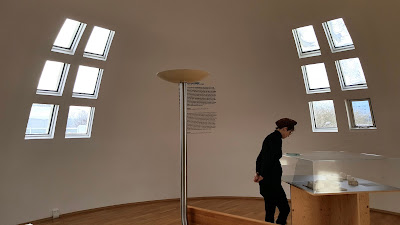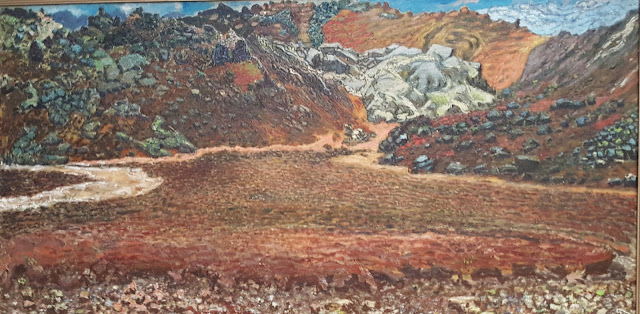Strolling the streets of Reykjavik you will come upon galleries, stores, places of historical or cultural interest, and plenty of tourist shops featuring everything "Viking" that you could desire. It's your choice, but to buy anything you must forget your penny pinching. Iceland is expensive!

I let myself purchase only one item, and thereafter could only look longingly at the ceramics and woolens without buying because my krona to dollar app told me, "Nay."

My one splurge was a linen table runner, an item I knew I would use and enjoy as a remembrance of my visit to Iceland. It was designed in Iceland, but I wondered, was it made in Iceland? I asked, and indeed, it was not, but made in Finland. Good enough.
There is some interesting architecture to be seen in Reykjavik, but not very much that is older than the 19th century. Reykjavik's progress into the society of travel worthy world capitals is a very recent one.
 |
| inside Harpa |
One example of modern architecture is Harpa, a jewel-like theater and cultural center by the harbor. At night, colored lights flash across its outer walls like the lights of the aurora borealis.

The clear glass windows fill the whitewashed interior with light, lending it a modern feeling despite the gothic vaulted ceiling.

You may take an elevator to the top, but a long line in the vestibule discouraged me. At night, I saw a beautiful effect created by light shining through many slit openings in the top of the steeple.
The line of people also blocked some of the large canvases on display that I admired.
The line of people also blocked some of the large canvases on display that I admired.
I saw ceramics for sale in all the museum and tourist shops as well as galleries. Here are but a few by ceramicist Olof Saemundsdottir at the Stigur gallery.
These bowls were quite large, perhaps 12 inches in diameter, the cups much smaller, all with a variety of glazes, but almost all with a white tint to them. There is something about white that appeals to the Nordic esthetic. I wonder why?
There is much more art to see in Iceland, but I and my group of explorers were keen to see the country, bask in hot springs and ride the Icelandic horses. But if you don't have our luck with the weather (sunny for 6 days straight) you can spend more time with the art of Iceland.




























